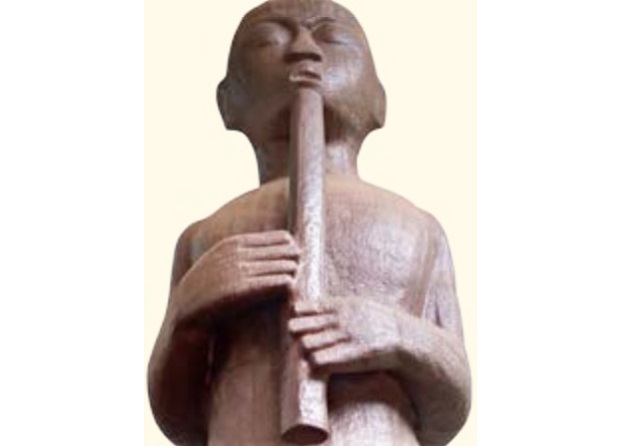
Musical instruments were depicted in gothic stone sculptures interrogating biblical themes
Kampala, Uganda | DOMINIC MUWANGUZI | The imposing in size sculpture standing in the foyer of the new Main Library building at Makerere University, immediately captures ones’ attention. Measuring over 25 feet tall, the colossal figurine represents a young boy playing a flute with his eyes closed; a demonstration of musical concentration. The Flute Boy 2000 is a wood curving in metallic protection. The wrapping of the figurine in metal plates is a figurative allusion to safety and protection the young man enjoys in a new environment. As such, the artist, Francis Xavier Nnagenda created the figurine to demonstrate to the public a thriving and young nation that is full of optimism. The idea of playing the flute is a representation of happiness, joy that comes with such prosperity. Similarly, its size symbolizes the artist’s creative ingenuity in pursuing unprecedented approaches to art production. Nnagenda’s name on the local art scene has been synonous with the production of large scale artworks that thrusted him onto global art stage.
Flute Boy is another demonstration of Nnagenda’s studio dexterity within the context of inconsistence in technique, style and subject matter. In the artwork, the artist seems to borrow a lot from Renaissance art that recurrently depicted musical instruments in the gothic stone sculptures. The 13th century sculptural works had images of angels or laymen playing string instruments, but later imagery of wind instruments like the flute were emerged in the artworks. The showcase of music instruments in the stone sculptures, juxtaposed with the dominant interrogation and expression of biblical themes in art during this period. The stone sculpture of King David and Queen Bathsheba, 1230-40 , portraying David playing the lyre, a North European musical string instrument, to Bathsheba gives ressonance to such approach. The posture of the player evokes an experienced instrumentalist who is serenading the love of his life. Similar depictions of stone figurines playing musical instruments are seen on ceilings or facades of churches symbolizing the emerging appreciation of these instruments as a powerful form of imagery in art. This probably was motivated by their diversity in cultural background and meaning. Therefore musical instruments of different types were depicted differently in the sculptural works to stimulate particular feelings and interpretations to the public.
The painting Boy Playing the Flute, 1635 by Judith Leyster is an inspiration from the trends of Renaissance art. This is similar to religious paintings of the same period that occasionally depicted different types of musical instruments in their compositions. Though it does not interrogate a biblical theme, it portrays a young boy playing a flute with the Violin and Pipe hanging in the background. Such is a demonstration of the affluent social background of the young man and his accomplished skills in playing a diversity of instruments. But the most interesting aspect of the painting is the youthfulness of the subject which quickly reminds us of Nnagenda’s Flute Boy. A youthful identity within the context of painting is a symbol of vitality, resourcefulness and promise. The Flute Boy standing in the Library hall is not only a representation of a new born and thriving nation, but an allusion to the vitality and resourcefulness that can be found in such a space. The library enables social cultural exchanges and learning that contribute to the development of society in the new millennium.
Nnagenda’s experimental approach in this extraordinary artwork is visible through working with Renaissance and modernist forms of art production which he integrated with is own indigenous art approach of wood curving. He further delved into the subject of innovation by working with metal plates as a gesture to the subject of appropriation in contemporary art. This technique is purposeful in providing alternative and inexpensive material that can substitute for conventional media. As an art academic, his undertakings seem to be contextualized within particular subjects of his academic interest. This background affords him an expanse wealth of knowledge that he’s eager to share with to the new generation of artists.
****
The sculpture was donated by the Rockefeller Foundation to the University Library
 The Independent Uganda: You get the Truth we Pay the Price
The Independent Uganda: You get the Truth we Pay the Price



What became of these artists.Lilian Bulime ,Nuwa wamala Nyanzi and other artists of the 1970s
Nuwa Nyanzi is still making art and can be found at the National Theatre were his studio is located. I hope by Lilian Bulime, you mean Lilian Mary Nabulime. Nabulime is still producing art and doubles as senior lecturer at Makerere art school ( MTSIFA). Nabulime is a second generation/ third generation artist and many her contemporaries are also still making art. Many artists from the 70s including Kefa Ssempagi are actively creating art